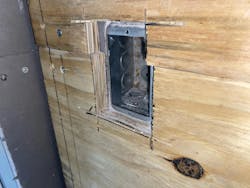How well do you know the Code? Think you can spot violations the original installer either ignored or couldn’t identify? Here's your chance to moonlight as an electrical inspector and second-guess someone else's work from the safety of your living room or office. Can you identify the specific Code violation(s) in this photo? Note: Submitted comments must include specific references from the 2023 NEC.
Hint: Panelboards in a public restroom?
Tell Them What They've Won…
Using the 2023 NEC, correctly identify the Code violation(s) in this month's photo — in 200 words or less — and you could win a Fluke Corporation iSee Mobile Thermal Camera. E-mail your response, including your name and mailing address, to [email protected], and Russ will select one winner (excluding manufacturers and prior winners) at random from the correct submissions. Note that submissions without an address will not be eligible to win.
August Winner
Our winner this month was Adam Mueller, director of engineering for Core States Energy of Somerville, N.J. He knew this box and plaster ring were set back too far into this wooden wall surface.
For installations in surfaces of wood or other combustible materials, Sec. 314.20 requires boxes, plaster rings, extension rings, and listed box extenders to be installed so they extend to the finished surface or project beyond the finished surface. It would be difficult at best to install a Code-compliant flush-mounted receptacle or switch in this box too since it would be virtually impossible to have the device and plate sit flush against the box. I have seen many installations where metal or plastic spacer sleeves were placed over the 6/32 device mounting screws between the box and the device yoke in order to provide a means to secure the device firmly against the spacers at the same level of the wall’s finished surface. This method is not a Code-compliant solution. However, installing a listed box extender could be used as a solution in this case. Keeping arcs and sparks away from combustible materials is an important step in minimizing the risk of fires.






